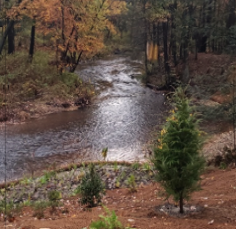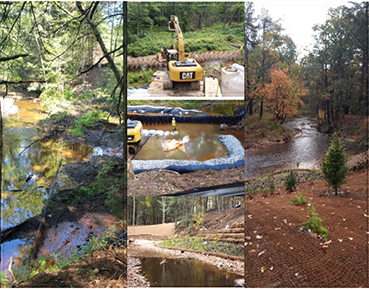
Remediation of Cadmium-Impacted Wetland: Restoring a Healthy Ecosystem
Restoring a Healthy Ecosystem by remediation and restoration for a cadmium-impacted wetland habitat in Westminster, MA.Byline: BTB Editor
April 27, 2023 / Time to read: 5 minThrough the acquisition of US Ecology, Republic Services remains committed to our mission of protecting human health and the environment. Wetlands have a special place in our hearts. They are highly productive and biologically diverse systems that enhance water quality, control erosion, maintain stream flows, sequester carbon and provide a home to at least one-third of all threatened and endangered species.
That’s why we were excited to support one of our aerospace industry customers on a project to remediate a wetland on their property in Westminster, Massachusetts. Previous site investigations indicated that upland and riverbank soils, as well as groundwater, were impacted by cadmium at concentrations exceeding regulatory levels. Soil erosion and impacted groundwater discharged into the Whitman River resulted in cadmium concentrations in the wetland hydric soil, river sediments and riverbank soil to greater than site-specific, risk-based clean-up goals.
We determined that the installation of temporary and intermediate erosion and sediment control were imminent and began operations by developing a plan with best management practices. Our team of professionals constructed a minimally invasive series of access travel paths through mature upper woodlands that led to the remote work area.
We installed a cofferdam to divert water flow and provide a safe and efficient work environment for our crew. During that installation, we discovered the riverbed profile required a different type of barrier. A thin veneer of sediment underlain by cobble resulted in significant water seepage and bypass. We decided to install an intermediate barrier wall using polyethylene-coated, one-cubic-yard “super sack” bags filled with certified clean aggregate to retard the cofferdam bypass. The barrier wall also served as a sedimentation barrier and turbidity curtain, retaining excavation materials and discharge from the heavy flow of the embankment seep. Later, we reused the certified clean aggregate within the super sacks as clean backfill after the cofferdam was removed. Within the cofferdam, we worked on dewatering, treatment and discharge. We excavated approximately 450 tons of RCRA-characterized soil, treated it with TerraBond® SC and transported it to a third-party facility for disposal. Additionally, our crew excavated and removed 100 tons of non-RCRA contaminated soil and conditioned it with a drying agent to prepare it for disposal.
A primary objective of the project was to restore the wetland in its configuration and elevation. To achieve that, we replaced the contaminated sediments with clean materials and revegetated the area with native plant species consistent with the existing conditions. To replicate the gradation of the riverbed cobble, we sourced harvested river rocks of multiple sizes, creating a custom blend to better imitate the natural composition of the riverbed. Stabilization served a dual purpose — to restore the areas disturbed during remediation and to protect the restored wetland area from river erosion during the grow-in phase.
In conformance with the Massachusetts Contingency Plan (MCP), Westminster Conservation Commission and U.S. Army Corps of Engineers/Massachusetts General Permit 17, the final remedy we implemented resulted in restored resource areas and a wetland that will once again contribute to ecosystem productivity.

